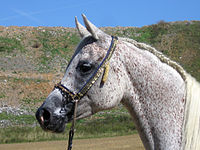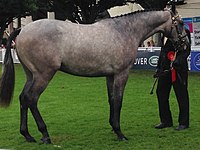Loading AI tools
| This article is rated Start-class on Wikipedia's content assessment scale. It is of interest to the following WikiProjects: | |||||||||||||||||||||
| |||||||||||||||||||||
| Text and/or other creative content from this version of gray (horse) was copied or moved into white (horse) with this edit on 17 July 2006. The former page's history now serves to provide attribution for that content in the latter page, and it must not be deleted as long as the latter page exists. |
I removed this incorrect fact:
- Unlike the frame overo gene, which causes all-white foals to die shortly after birth (called "lethal white syndrome"), sabinos can be born entirely white and be perfectly healthy.
See lethal white syndrome. The "lethal white is homogeneous frame overo" theory was an unsubstantiated theory predating the blood test; in fact the lethal white gene is not carried by all frame overos, and is even carried by non-overos. Deco 20:44, 2 September 2005 (UTC)
I'm going to peruse the UC Davis web site on this and see if we can straighten this mess out. Bottom line is that there are no true albino horses. Never happens, never has happened, and not sure what theories are all out there, but I guess we all just try to cite the state of the art research.Montanabw 22:11, 6 June 2006 (UTC)
- See the references in the Lethal white syndrome article, in particular this one. Lethal white is not caused by a homozygous frame overo, and this has been definitively established by accredited research; Laurie Fio's theory, which was never substantiated by experiments, has been discredited by new research. I also normally trust the VGL as a reliable resource, but there's no way they can reconcile their own statement that "not all overos are carriers" with this homozygous overo model. Moreover, lethal white foals are not "born dead" - they typically live for up to a few days after birth before they die. Deco 21:44, 6 June 2006 (UTC)
I'll tweak that they aren't born dead...I guess it's the WW foals that are born dead. The UC Davis site seems to be standing behind Fio's research, but I'll look at the APHA site too, double check against the Lethal White Wiki page and see if we can merge the competing theories together, or at least explain that there is more than one view on this. (Looks like the APHA article cites research at U Minnesota from 1998, can you locate a direct cite to that research so we can have "dueling universities?"
I don't breed Paints, so I don't have a horse in this race, which I HOPE will keep me neutral on this issue.Montanabw 22:11, 6 June 2006 (UTC)
- The link I gave above summarizes some of the U Minn research, although I don't have access to the original article. It is true that there's a single gene responsible for it, but that gene certainly doesn't cause overo coloring if non-overos carry it, as both VGL and U Minn assert. In the U Minn article they refer to the allele using "L". I've contacted VGL for clarification on Fio's theory a couple times, but they haven't responded yet. If you think Fio's theory deserves to be treated as equally credible, I guess that's okay, but please don't give the impression that all overos or only overos are carriers, which could lead to dangerous breeding practices. Deco 22:41, 6 June 2006 (UTC)
- Oh, by the way, I agree with the current wording, so if you're happy with that we're settled. :-) Deco 22:54, 6 June 2006 (UTC)
Check my last sets of tweaks. I'm done being a Wikipedian for the day, so if I haven't destroyed anything since your last check, life is good. Someone (maybe me, maybe not) should just create a white (color) horse page, move all this stuff over there and just link to it from the gray page...that way they can also put the fleabitten gray stub back into this article. Montanabw 23:01, 6 June 2006 (UTC)
- I think that's a good idea. The only obvious connection between them is the final visual appearance of their coats. The article on white horses could also mention a variety of other "white" horses that aren't really white, like cremellos, perlinos, maximally-expressed sabinos and so on. Deco 23:07, 6 June 2006 (UTC)
Deco, didn't the APHA article also show a photo of a "maximally-expressed" Paint of some sort--a genetic Overo or Tobiano?? If I get motivated to do the White horse page, it is probably worth adding in ALL the ways a horse can wind up white (other than peroxide bleach!<grin>) Montanabw 15:18, 7 June 2006 (UTC)
Broke out the lethal white stuff into its own section. Anything--pro or con-- on this controversy needs to be cited and sourced. Please read material carefully before editing on this topic, and if anything currently there is wrong, then please cite SCIENTIFIC sources, and preferably phrase it as a controversy instead of doing any wholesale deletion or broad statements.
In other words, instead of saying "UC Davis is wrong," say something like, "there are two views on this issue. On one hand, original research at UC Davis says X, while on the other hand, a more recent study at U Minn says Y." And cite source. I tried to do this with earlier material.
This whole bit on white horses really needs its own article, not to be the unwanted stepchild of the Gray article. But I haven't had the time to do it. Be easy--just cut and paste Montanabw 21:21, 17 July 2006 (UTC)
Wikiwand in your browser!
Seamless Wikipedia browsing. On steroids.
Every time you click a link to Wikipedia, Wiktionary or Wikiquote in your browser's search results, it will show the modern Wikiwand interface.
Wikiwand extension is a five stars, simple, with minimum permission required to keep your browsing private, safe and transparent.











